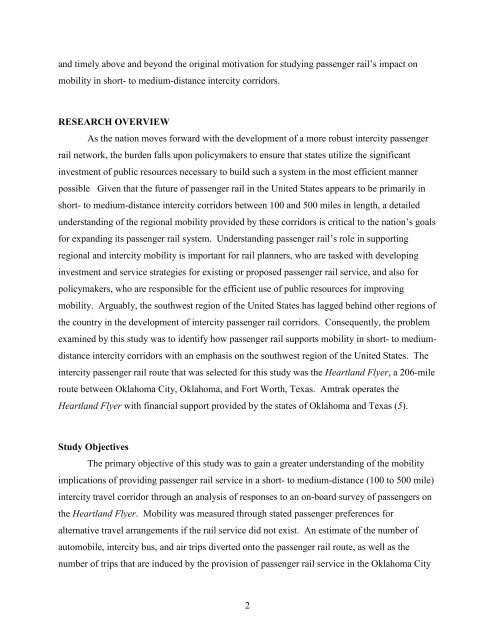Measuring the Benefits of Intercity Passenger Rail: A Study
Measuring the Benefits of Intercity Passenger Rail: A Study
Measuring the Benefits of Intercity Passenger Rail: A Study
Create successful ePaper yourself
Turn your PDF publications into a flip-book with our unique Google optimized e-Paper software.
and timely above and beyond <strong>the</strong> original motivation for studying passenger rail’s impact on<br />
mobility in short- to medium-distance intercity corridors.<br />
RESEARCH OVERVIEW<br />
As <strong>the</strong> nation moves forward with <strong>the</strong> development <strong>of</strong> a more robust intercity passenger<br />
rail network, <strong>the</strong> burden falls upon policymakers to ensure that states utilize <strong>the</strong> significant<br />
investment <strong>of</strong> public resources necessary to build such a system in <strong>the</strong> most efficient manner<br />
possible Given that <strong>the</strong> future <strong>of</strong> passenger rail in <strong>the</strong> United States appears to be primarily in<br />
short- to medium-distance intercity corridors between 100 and 500 miles in length, a detailed<br />
understanding <strong>of</strong> <strong>the</strong> regional mobility provided by <strong>the</strong>se corridors is critical to <strong>the</strong> nation’s goals<br />
for expanding its passenger rail system. Understanding passenger rail’s role in supporting<br />
regional and intercity mobility is important for rail planners, who are tasked with developing<br />
investment and service strategies for existing or proposed passenger rail service, and also for<br />
policymakers, who are responsible for <strong>the</strong> efficient use <strong>of</strong> public resources for improving<br />
mobility. Arguably, <strong>the</strong> southwest region <strong>of</strong> <strong>the</strong> United States has lagged behind o<strong>the</strong>r regions <strong>of</strong><br />
<strong>the</strong> country in <strong>the</strong> development <strong>of</strong> intercity passenger rail corridors. Consequently, <strong>the</strong> problem<br />
examined by this study was to identify how passenger rail supports mobility in short- to medium-<br />
distance intercity corridors with an emphasis on <strong>the</strong> southwest region <strong>of</strong> <strong>the</strong> United States. The<br />
intercity passenger rail route that was selected for this study was <strong>the</strong> Heartland Flyer, a 206-mile<br />
route between Oklahoma City, Oklahoma, and Fort Worth, Texas. Amtrak operates <strong>the</strong><br />
Heartland Flyer with financial support provided by <strong>the</strong> states <strong>of</strong> Oklahoma and Texas (5).<br />
<strong>Study</strong> Objectives<br />
The primary objective <strong>of</strong> this study was to gain a greater understanding <strong>of</strong> <strong>the</strong> mobility<br />
implications <strong>of</strong> providing passenger rail service in a short- to medium-distance (100 to 500 mile)<br />
intercity travel corridor through an analysis <strong>of</strong> responses to an on-board survey <strong>of</strong> passengers on<br />
<strong>the</strong> Heartland Flyer. Mobility was measured through stated passenger preferences for<br />
alternative travel arrangements if <strong>the</strong> rail service did not exist. An estimate <strong>of</strong> <strong>the</strong> number <strong>of</strong><br />
automobile, intercity bus, and air trips diverted onto <strong>the</strong> passenger rail route, as well as <strong>the</strong><br />
number <strong>of</strong> trips that are induced by <strong>the</strong> provision <strong>of</strong> passenger rail service in <strong>the</strong> Oklahoma City<br />
2
















